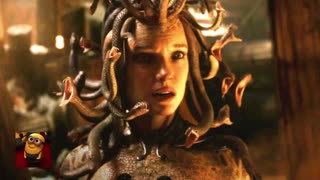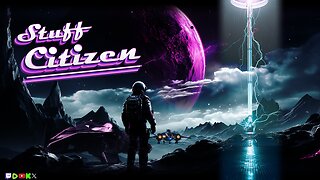Premium Only Content

MEGALOPOLIS Trailer 2 (2024) Aubrey Plaza, Nathalie Emmanuel
MEGALOPOLIS Trailer 2 (2024) Aubrey Plaza, Nathalie Emmanuel
MEGALOPOLIS Trailer 2 (2024) Adam Driver, Francis Ford Coppola, Aubrey Plaza, Shia LaBeouf, Nathalie Emmanuel
© 2024 - Lionsgate
Here’s your first look at Francis Ford Coppola’s much-talked-about Megalopolis, starring Adam Driver.
Directed by Coppola from a screenplay he also wrote, the film debuted at this year’s Cannes Film Festival. The film is described as a “Roman Epic set in an imagined Modern America.”
The synopsis reads: The City of New Rome must change, causing conflict between Cesar Catilina (Adam Driver), a genius artist who seeks to leap into a utopian, idealistic future, and his opposition, Mayor Franklyn Cicero (Giancarlo Esposito), who remains committed to a regressive status quo, perpetuating greed, special interests, and partisan warfare. Torn between them is socialite Julia Cicero (Nathalie Emmanuel), the mayor’s daughter, whose love for Cesar has divided her loyalties, forcing her to discover what she truly believes humanity deserves.
Related Stories
'Wild Robot' and 'Megalopolis'
'Wild Robot' Powers To Third Best September Animated Debut With $35M; 'Megalopolis' Collapses With $4M & D+ CinemaScore; 'Saturday Night' Alive In Limited Release -- Sunday Box Office Update
Clockwise Top L-R: Lee, My Old Ass, Megalopolis, Vindicating Trump, Azrael
Crowded Indie Market Ratchets Up Competition For An Uncertain Audience - Specialty Preview
Starring alongside Driver are Esposito, Emmanuel, Aubrey Plaza, Shia LaBeouf, Jon Voight, Laurence Fishburne, Kathryn Hunter, and Dustin Hoffman. Producers on the film are Barry Hirsch, Fred Roos, and Michael Bederman.
Watch on Deadline
As has been reported widely, Coppola self-financed the film, which is his first feature since 2011’s Twixt. Lionsgate will be releasing the film stateside on Sept. 27. The studio has long been in business with Coppola’s American Zoetrope banner having released the Oscar-winning filmmaker’s previous director’s cuts, i.e. Apocalypse Now Final Cut, The Conversation, The CottonClub Encore, Tucker: The Man and HisDream, and One From the Heart: Reprise. Lionsgate Studios will also handle the distribution of Megalopolis across all home entertainment platforms.
Check out the Megalopolis trailer above.
Must Read Stories
Hide Articles
Halle Berry Lands Female Lead Opposite Chris Hemsworth In Thriller ‘Crime 101’
Par Preps Live-Action Hybrid ‘Rugrats’ Pic With ‘Pitch Perfect’ Helmer Jason Moore
Sarah Snook Sets Spring Broadway Debut With ‘The Picture Of Dorian Gray’
Actor’s Daughter Learned Of His August 21 Death Through Media Reports Tuesday
Read More About:
Francis Ford Coppola
Megalopolis
Megalopolis[a] is a 2024 American epic science fiction drama film written, directed, and produced by Francis Ford Coppola. The film stars Adam Driver, Giancarlo Esposito, Nathalie Emmanuel, Aubrey Plaza, Shia LaBeouf, Jon Voight, Laurence Fishburne, Talia Shire, Jason Schwartzman, Kathryn Hunter, Grace VanderWaal, Chloe Fineman, James Remar, D. B. Sweeney, and Dustin Hoffman. Set in an imagined modern United States, it follows visionary architect Cesar Catilina (Driver) as he clashes with the corrupt Mayor Franklyn Cicero (Esposito) in determining how to rebuild the metropolis of New Rome as "Megalopolis", a futuristic utopia. The film references the characters involved in the Catilinarian conspiracy of 63 BC, including Catiline and Cicero, in addition to Caesar.
In development for decades, Megalopolis came from Coppola's desire to make a film drawing parallels between the fall of Rome and the future of the United States by setting the events of the Catilinarian conspiracy in modern New York City. He conceived the idea for the film in 1977 and actively started developing it in 1983 by assembling notes for a future script. Preparations for a film based around his initial concept came together in 1989 to be shot in Rome, but it was postponed after Coppola prioritized other projects to pay his debt to Hollywood after a string of box-office disappointments. Coppola revived the project in 2001, holding table reads with prominent actors in New York. After the September 11 attacks, an event that resembled the film's plot and themes, Megalopolis was again abandoned. Having become disheartened working for the studio system, Coppola soon after declared his intentions to self-finance the project if it ever came to fruition.
Coppola announced his return to the film in 2019 and, two years after, sold a portion of his winery in California to spend $120 million of his own money to fund it. After a delay caused by the COVID-19 pandemic, casting was underway by 2021. The film reunited Coppola with past collaborators, including actors Esposito, Fishburne, Remar, Shire, and Sweeney, cinematographer Mihai Mălaimare Jr., second-unit director Roman Coppola, and composer Osvaldo Golijov. Principal photography took place from November 2022 to March 2023, in Georgia. Coppola adopted an experimental style that permitted improvisation during the shoot by letting actors write scenes and himself make spontaneous changes to the script. These methods proved divisive, leading to the resignation of the art department and visual effects team, among others, and raising comparisons to Coppola's history of challenging productions. Filming reportedly wrapped ahead of schedule.
Megalopolis was selected to compete for the Palme d'Or at the 77th Cannes Film Festival, where it premiered on May 16, 2024, and polarized critics. The film struggled to secure distribution due to Coppola's financial demands, with Lionsgate acquiring domestic rights after he compromised to cover marketing costs. In the run-up to release, a trailer was removed for using fabricated pull quotes, and allegations of on-set misconduct were made against Coppola, for which he filed a libel lawsuit against Variety for publicizing them. The film was theatrically released in the United States on September 27, and has grossed $5.3 million.
Plot
In an alternate present-day "American Republic", Cesar Catilina clashes with the New Rome city mayor Franklyn Cicero. Cesar is the inventor of Megalon, a revolutionary new bio-adaptive building material he believes can change the world, and has ambitious plans to utilize it to construct "Megalopolis", a futuristic utopian city of his own design. After Cesar announces his intentions in a televised speech, Cicero leads a smear campaign against him involving the death of his wife and the post-mortem disappearance of her body in unexplained circumstances.
TV presenter Wow Platinum, Cesar's mistress, leaves him to marry Hamilton Crassus III, an extremely wealthy elderly bank CEO and Cesar's uncle. Shortly afterward, Cesar becomes acquainted with Julia, Cicero's well-read daughter. While initially distrusting and spying on him, she soon develops feelings for him. When Julia reveals herself immune to Cesar's ability to stop time, he brings her on to assist in the Megalopolis project.
At a lavish and decadent wedding reception for Wow Platinum and Crassus, Cesar takes drugs backstage. Clodio Pulcher, Crassus's depraved nephew, sabotages the show to implicate Cesar in a sex scandal involving Vesta, a teenage pop star with a virginal image. Cesar is arrested but ultimately cleared of any wrongdoing and released, while Vesta continues her career after adopting a new rebellious and sexually charged persona. Soon, Cesar and Julia become romantically involved. Cesar laments the loss of his ability to stop time following his arrest but finds himself able to do it with Julia.
The Soviet Union satellite, "Carthage", falls out of orbit over New Rome, destroying large parts of the city. Cesar uses the opportunity to begin construction of Megalopolis, despite Cicero's opposition. In a press conference, he urges the need for debate and dialogue about society and asks people to consider if a better world is possible. Cesar is delighted to learn that Julia is pregnant, while Cicero is aghast. Privately, he pleads with Cesar to leave his daughter, attempting to bribe him with information about what happened to his wife, but Cesar refuses. Clodio begins stirring up popular discontent against both Cesar and Cicero with fascist rhetoric, while separately, Wow Platinum convinces him to assist her in a plan to take control of Crassus's fortune via hostile takeover, freezing Cesar's bank accounts in the process.
Cesar is shot in the head and severely wounded in an assassination attempt but heals quickly thanks to a Megalon skin graft. The protests against Cesar and Cicero led by Clodio turn into full-scale riots, and Cicero flees to a secret underground bunker. After being forced from his position as bank CEO by the board of directors, Crassus confronts Wow Platinum and Clodio with a bow and arrow, killing Platinum and wounding Clodio. Confronting protestors at Megalopolis, Cesar gives an impassioned speech about the future and wins the crowd over. Clodio's protestors turn against him, and he has his body strung up by an angry mob. Crassus pledges to use his wealth to support the construction of Megalopolis.
Sometime later, the construction of Megalopolis is completed. Cicero, holding Julia and Cesar's baby daughter, Sunny Hope, promises to work together with Cesar to keep building a better future. On New Year's Eve, Cesar stops time once more, but only Sunny Hope seems unaffected.
Cast
Adam Driver as Cesar Catilina, a futuristic architect and the Chairman of the Design Authority in New Rome, blessed with the ability to stop time[5]
Giancarlo Esposito as Mayor Franklyn Cicero, the arch-conservative mayor of New Rome[5]
Nathalie Emmanuel as Julia Cicero, Cesar's love interest and Cicero's daughter[5]
Aubrey Plaza as Wow Platinum, a TV presenter specializing in financial news who desires money and power[5]
Shia LaBeouf as Clodio Pulcher, Cesar's jealous cousin[1]: 13 [5]
Jon Voight as Hamilton Crassus III, Cesar's wealthy uncle and the head of Crassus National Bank[5][6]
Laurence Fishburne as Fundi Romaine (the film's narrator), Cesar's driver and assistant[7]
Talia Shire as Constance Crassus Catilina, Cesar's mother[8]
Jason Schwartzman as Jason Zanderz, a member of Cicero's entourage[8]
Kathryn Hunter as Teresa Cicero, Cicero's wife[8]
Grace VanderWaal as Vesta Sweetwater, a virginal teen pop star[5]
Chloe Fineman as Clodia Pulcher[9]
James Remar as Charles Cothope[9]
D. B. Sweeney as Commissioner Stanley Hart[9]
Isabelle Kusman as Claudine Pulcher[9]
Bailey Ives as Huey Wilkes[9]
Madeleine Gardella as Claudette Pulcher[1]: 34
Balthazar Getty as Aram Kazanjian, Clodio's right-hand man[8]
Romy Mars as a reporter[10]
Haley Sims as Sunny Hope Catilina[9]
Dustin Hoffman as Nush Berman, Cicero's fixer[8]
Production
Development
Filmmaker Francis Ford Coppola at the 2001 Cannes Film Festival in Cannes, France.
Writer, director, and producer Francis Ford Coppola in 2001
Growing up in New York City, Francis Ford Coppola was fascinated by science fiction films, such as Fritz Lang's Metropolis (1927) and William Cameron Menzies's Things to Come (1936), and the scientific community's history with dangerous experiments.[11] His reading of the Roman historian Sallust and William Bolitho Ryall's book Twelve Against the Gods (1929) inspired him to make a film about Lucius Sergius Catiline, who sought consulship by campaigning to eliminate debt for the poor and wealthy, but lost to Marcus Tullius Cicero, who famously denounced Catilina before the Senate for conspiring to overthrow the Roman Republic in 63 BC.[1]: 7 Coppola conceived the overall idea for Megalopolis towards the end of filming Apocalypse Now (1979) in 1977.[12]: 50 Sound designer Richard Beggs described Coppola's vision as an opera screened over four nights, similar to Richard Wagner's Ring cycle (1876) in Bayreuth, in a "gigantic outdoor purpose-built theatre" in "some place as close as possible to the geographical center of the United States", for example the Red Rocks Amphitheatre in the state of Colorado.[13][14]: 181
Coppola devoted the beginning of 1983 to developing the film, assembling four hundred pages of notes and script fragments in two months.[15]: 333 Over the next four decades, he collected notes and newspaper clippings for scrapbooks detailing intriguing subjects he envisioned incorporating into a future screenplay, like political cartoons and different historical subjects, before deciding to make a Roman epic film set in an imagined modern America.[11][16] In mid-1983, he described the plot as taking place in one day in New York City with Catiline Rome as a backdrop, similar to how James Joyce's modernist novel Ulysses (1922) used Homer in the context of modern Dublin and how he had updated the setting of Joseph Conrad's novella Heart of Darkness (1899) from the late 1800s amid European colonial rule in Africa to the 1970s Vietnam War for Apocalypse Now.[11][17]: 74 [18]: 215
In January 1989, Coppola announced his plans to move to Italy to work on two productions in the next five years, including Le Ribellion di Catilina, a film "so big and complicated it would seem impossible", which biographer Michael Schumacher said "sounded much like what he had in store for Megalopolis".[15]: 409–410 It was to be shot in Cinecittà, a film studio in Rome, where production designer Dean Tavoularis and his design team built offices and an art studio for drafters to storyboard the film.[19]: 266 [20]: 234 The Hollywood Reporter described it as "swing[ing] from the past to the present", merging "the images of Rome ... with the New York of today". Of it, Coppola said, "I want to be free. I don't want producers around me telling me what to do." Coppola ultimately did not move to Italy, and instead made The Godfather Part III (1990).[15]: 410 Following the 1990–91 film awards season for that film, Coppola's production company, American Zoetrope, announced several projects in development, including plans to film Megalopolis in 1991, despite lacking a finished script.[15]: 436 However, the film was postponed to "no earlier than 1996" after Coppola found himself prioritizing other projects, including Bram Stoker's Dracula (1992), Jack (1996), and The Rainmaker (1997), to get out of debt accumulated from the box-office failures of One from the Heart (1982) and Tucker: The Man and His Dream (1988).[15]: 444 [21]: 110 [22]
"Do films the same way Ingmar Bergman did them, with a little group of collaborators that you know, making a script that you wrote. Otherwise, you will finally get beaten down by the fact that you are making things that you are not really interested in, from a script that you don't fully understand, by means that you don't approve of. The question is: Can you make bigger films, like Megalopolis or Cure, in that way? Certainly, the determining factor is the cast, because with a star cast comes the financing ..."
— Coppola, diary entry (August 15, 1992)[23]: 28
Coppola returned to the film after directing The Rainmaker.[16] In 2001, he held table reads in a production office in Park Slope, Brooklyn, with actors including Nicolas Cage (his nephew), Russell Crowe, Robert De Niro, Leonardo DiCaprio, Giancarlo Esposito, Edie Falco, James Gandolfini, Jon Hamm, Paul Newman, Al Pacino, Parker Posey, Kevin Spacey, and Uma Thurman.[11][19]: 262 [24][25][26] Matt Dillon, approached during the filming of Rumble Fish (1983) for the role of a West Point cadet who goes AWOL, was now considered "too old for the part".[27] In July, Coppola dispelled rumors he had written a part for Warren Beatty.[28] Jim Steranko, who previously created production illustrations for Bram Stoker's Dracula, produced concept art for Megalopolis at Coppola's behest, described in James Romberger's master's thesis as "expansive, elaborate and carefully rendered pencil or charcoal halftone architectural drawings of huge buildings and urban plazas that appeared to mix ancient Roman, art deco and speculative sci-fi stylizations".[12]: 54 Proposed filming locations included the cities of Montreal and New York, with an anticipated budget of $50–80 million (equivalent to $82.2 million to $131 million in 2023).[19]: 263 [28][29]
That year, Coppola and cinematographer Ron Fricke recorded second unit footage of New York, thinking it would be simpler to do so before principal photography, with the 24-frames per second Sony F900 digital camera that George Lucas used for Star Wars: Episode II – Attack of the Clones (2002).[11][29] Fricke had previously shot Godfrey Reggio's Koyaanisqatsi (1982) and Powaqqatsi (1988), films which Coppola executive produced.[16][19]: 263 After the September 11 attacks, during which Coppola and his team were location scouting in New York, the roughly thirty hours of footage was stashed, including more material they shot two weeks after, due to its resemblance to the script, which involved a Soviet satellite crashing into Earth and destroying a section of Lower Manhattan.[12]: 54 [19]: 263 [30][31] "I feel as though history has come to my doorstep", Coppola said in October, declaring his plans to rewrite the film.[29] In 2002, he shot sixty to seventy hours of second unit footage in Manhattan on high-definition video that Lucas described as "wide shots of cities with incredible detail at magic hour and all kinds of available-light material".[19]: 263 [32][33]: 82 He also disclosed his intent to self-finance the film, still in place as his next project, having become disheartened making films to pay off his debt to Hollywood.[27][34]
Production on the film eventually halted. The success of his winery and resorts meant Coppola could produce it with his own money, which his friend Wendy Doniger said "paralyzed him", adding that, "He had no excuse this time if the film was no good. What froze him was having the power to do exactly what he wanted so that his soul was on the line".[35] In 2005, she gave him books that she deemed thematically relevant, including Mircea Eliade's Youth Without Youth (1976), a novella about a 70-year-old man struggling to complete an ambitious project. Coppola then shelved Megalopolis to self-finance a small-scale adaptation of the book, intended to be "the opposite of Megalopolis".[33]: 85 [35] In 2007, Coppola admitted that 9/11 "made it really pretty tough ... a movie about the aspiration of utopia with New York as a main character and then all of a sudden you couldn't write about New York without just dealing with what happened and the implications of what happened. The world was attacked and I didn't know how to try to do with that [sic]. I tried".[22] In 2009, in regards to the likelihood of revisiting the film, he said, "Someday, I'll read what I had on Megalopolis and maybe I'll think different of it, but it's also a movie that costs a lot of money to make and there's not a patron out there. You see what the studios are making right now."[36] In 2017, celebrity chef Anthony Bourdain invited Coppola on his travel show in Sicily. Coppola took note of his weight gain when he saw his episode and signed up for a five-month program at Duke University's fitness center, where he lost close to 80 pounds. Of it, he said, "On the days where it would be these strict exercise regimens, I started listening to some of the readings of Megalopolis just for the hell of it, and thought, 'This feels more relevant than ever.' I realized that even though the script was 20 years old, I could still do it." He described the 2001 draft as the "pregnant version of it, but it wasn't all that similar", and said Gandolfini gave him "a lot of great suggestions" back when he read for the part of the mayor.[37][38]
Pre-production
The cast of Megalopolis
Adam Driver at a film premiere in Tokyo, Japan, in 2017
Giancarlo Esposito at SXSW in 2017
Nathalie Emmanuel at San Diego Comic-Con in San Diego, California, in 2017
Aubrey Plaza at the Cannes Film Festival in Cannes, France, in 2024
Shia LaBeouf at the Toronto Film Festival in Toronto, Canada, in 2017
Jon Voight at an event in Bethesda, Maryland, in 2012
Top: Adam Driver, Giancarlo Esposito, and Nathalie Emmanuel
Bottom: Aubrey Plaza, Shia LaBeouf, and Jon Voight
On April 3, 2019, the day before his 80th birthday, Coppola announced his return to the project, having completed the script and approached Jude Law and Shia LaBeouf for lead roles.[39][30] In 2021, Coppola sold his Sonoma County wineries to merge his winery business with that of another Napa-based family company, Delicato Family Wines, in an equity deal worth around $650 million. He then borrowed $200 million against his ownership stake in Delicato to fund Megalopolis for $120 million and pay for other projects at Inglenook and Sentinel Building.[40][41] By August, discussions with actors to star in the film had begun; James Caan was set to star after petitioning Coppola to write him a cameo role as a potential swan song, while Cate Blanchett, Oscar Isaac, Jessica Lange, Michelle Pfeiffer, Jon Voight, Forest Whitaker, and Zendaya were in various stages of negotiations.[1]: 3 [42]
In late 2021, Nathalie Emmanuel auditioned over Zoom while filming The Invitation (2022) in Budapest. During the session, Coppola had her participate in an acting exercise, tasking her with reciting a line from Alice Walker's novel The Color Purple (1982) in as many different contexts.[1]: 3 [43][44] By March 2022, Talia Shire (Coppola's sister) expressed her interest in joining the cast and Isaac was reported to have passed on the project.[45][46] By May, Emmanuel, Voight, and Whitaker were confirmed for the cast, with Adam Driver and Laurence Fishburne added.[47] Coppola was reassured Driver was "his kind of actor" after hearing an anecdote from Martin Scorsese about Driver's method acting for Silence (2016).[48] Driver originally demurred from accepting the lead role but reconsidered after Coppola incorporated ideas they developed together.[1]: 3 After Caan died on July 6, 2022, his role was given to Dustin Hoffman.[1]: 3 [49]
In August 2022, Kathryn Hunter, Aubrey Plaza, James Remar, Jason Schwartzman (Coppola's nephew and Shire's son), and Grace VanderWaal joined the cast, with LaBeouf and Shire confirmed as part of it.[50][51] Plaza auditioned over Zoom similarly to Emmanuel sometime in 2022 during the production of the second season of The White Lotus while staying at the San Domenico, the same hotel in Italy that Coppola resided in during the filming of The Godfather (1972). Before the meeting, Coppola emailed her the entire script and asked her to consider the role of "Wow Platinum", wanting an actress with a similar screen presence to Jean Harlow and Myrna Loy in screwball comedies from the 1930s.[1]: 3 [52] Chloe Fineman, Madeleine Gardella, Hoffman, Bailey Ives, Isabelle Kusman, and D. B. Sweeney would be added in October.[53] Coppola had reached out to Fineman, a cast member on Saturday Night Live, in 2020 after seeing her perform at a theater comedy event where she impersonated Ivana and Melania Trump.[54][55] In January 2023, Esposito was confirmed to star;[56] he previously starred in Coppola's The Cotton Club (1984). His character of Mayor Franklyn Cicero was loosely inspired by Marcus Tullius Cicero and New York's first Black mayor David Dinkins.[26] VanderWaal, a musician who won America's Got Talent at age 12 in 2016 and whom Coppola met through her father, wrote two original songs for the film.[57][58] Esposito, Fishburne, Remar, Shire, and Sweeney previously worked with Coppola.[1]: 2 Coppola opted to cast actors with differing political ideologies to avoid accusations of the film being a didactic, "woke Hollywood production".[37]
The film was influenced by the books Bullshit Jobs (2018), The Dawn of Everything (2021), and Debt: The First 5000 Years (2011) by David Graeber; The Chalice and the Blade (1987) by Riane Eisler; The Glass Bead Game (1943) by Hermann Hesse; The Origins of Political Order (2011) by Francis Fukuyama; The Swerve (2011) by Stephen Greenblatt; and The War Lovers (2010) by Evan Thomas.[59] The character of Cesar was based on Catiline and renamed at classicist Mary Beard's suggestion that Julius Caesar had ties with Catiline and was far more known among audiences. Coppola said the character was inspired by Robert Moses as portrayed in Robert Caro's biography The Power Broker (1974) and architects Norman Bel Geddes, Walter Gropius, Raymond Loewy, and Frank Lloyd Wright. Coppola also researched the Claus von Bülow murder case, the Mary Cunningham-William Agee Bendix Corporation scandal, the emergence of New York Stock Exchange reporter Maria Bartiromo, the history of Studio 54, and Felix Rohatyn's solution for the New York City fiscal crisis of 1975.[11] The fictional building material of Megalon was based in part on the work of architect and designer Neri Oxman, who appears in the film as "Dr. Lyra Shir" and was credited as the architectural and scientific advisor. She previously did a study titled Man-Nahāta, a four-part model installation about the potential future design of Manhattan.[1]: 10, 35 In line with The Godfather and Dracula, where he credited Mario Puzo and Bram Stoker as the original writers, Coppola branded the film with his name as Francis Ford Coppola's Megalopolis.[11]
The COVID-19 pandemic delayed the start of production. Before filming began, a week of rehearsals took place with theater-style exercises, much like the one Emmanuel described having in her audition.[43] Coppola said he could only rehearse with around a third of the cast, including Plaza and Emmanuel, but notably not Driver, and thus cast understudies in place of absent members.[37][60] Plaza described the workshop-style approach as allowing actors to improvise and provide feedback to the script, adding, "We wrote scenes and we conducted ourselves like a theater troupe, me and Jon Voight and Shia [LaBeouf]. We were writing scenes and giving them to the script supervisor. And then she would give them to Francis and sometimes he would like it and put it in. But every day he wanted to play. He ran it like it was a theater camp. There were games all day, and we were in character the whole time."[52] One such scene that the actors composed was the part where Plaza's "Wow Platinum" orders LaBeouf's "Clodio Pulcher" to "orally pleasure her as he calls her Auntie Wow", building off an idea of Coppola's.[61] Coppola described LaBeouf as an actor who "deliberately sets up a tension between himself and the director to an extreme degree" and whose "method was so infuriating and illogical, it had me pulling my hair out", which he compared to the preparations of actor Dennis Hopper for Apocalypse Now.[37][62]
Filming
The film was shot at Trilith Studios.
Principal photography began on November 7, 2022, in Fayetteville, Georgia, at Trilith Studios and concluded on March 11, 2023. Filming also took place in Atlanta.[1]: 3 It was to be the first film shot on Trilith Studios' Prysm Stage, an LED virtual production volume, but due to budget constraints, the production pivoted to a "less costly, more traditional greenscreen approach".[63][64][65] The decision to film in Georgia over the film's setting of New York was due to available tax benefits, studio facilities, local crews, and classical buildings to act as sets.[1]: 3 [13] Around July 2023, close to when editing began, additional content was shot on the Italy–Switzerland border.[66]
For the production, Coppola purchased a drive-in Days Inn motel for $4.35 million to reside in and accommodate the crew and his extended family. He renovated the motel to include facilities for rehearsal and post-production; by converting it into a production facility, he also increased the tax incentives he received from the state, reportedly bringing production costs down to $107 million.[41] The building in Peachtree City, Georgia, was later opened to the public by Coppola on July 5, 2024, as the All-Movie Hotel.[67] It offers hospitality and facilities needed to make films, including 27 rooms, two edit suites with laser projection and Meyer Sound 2.1 monitoring, two edit bays, offices, an ADR recording room, a conference room, an insert stage, a convivial space, and a screening room for private viewings, editing, or 9.1.6 Dolby Atmos sound mixing with calibrated Meyer sound monitoring, plus a swimming pool, wardrobe fitting room, and gym.[68] Memorabilia from Coppola's previous films is displayed throughout the hotel.[67]
The cinematographer was Mihai Mălaimare Jr., who shot Coppola's Youth Without Youth (2007), Tetro (2009), and Twixt (2011).[69] The crew utilized two Arri Alexa 65s and one Alexa LF for high-speed frame rate for the first unit and an Alexa Mini LF for the second unit. Panavision provided the lenses, including wide Sphero 65s, Panaspeeds, and specialty lenses such as the 200 mm and 250 mm detuned Primo Artiste, rehoused Helios, and Lensbaby for specific scenes. The primary aspect ratio was 2:1, a tribute to Vittorio Storaro's Univisium, with select scenes changing to a 1.43:1 aspect ratio.[1]: 16 [70] To capture authenticity from the actors, Coppola instructed Mălaimare to keep the camera rolling after he said "cut".[60] Some male actors donned Caesar cuts, in reference to ancient Rome.[71] For Plaza, the last two weeks of the shoot overlapped with her role on the television series Agatha All Along. As they were shot on the same lot, she was allowed to do both.[52] In August 2023, during the SAG-AFTRA strike, the film received an interim agreement from the union, possibly for reshoots or publicity purposes to qualify for festival screenings and distribution deals.[72][73] The final film includes footage shot in 2001, consisting of establishing shots of New York City and minimal video of the September 11 attacks out of respect for the families of the victims.[74][75]
Alleged conflicts on set
Creative differences
Plaza spoke positively about Coppola's willingness to experiment and how sometimes "all of a sudden, he would have another idea. And then all of a sudden, we're shooting in a different location we didn't even plan to shoot. And then the whole day goes by and you're like, 'I had no idea any of that was going to happen'".[52] Others described that approach as "exasperating" and "old-school", as Coppola was hesitant to decide how the film would look and would spend work days completing shots practically instead of relying on digital techniques. One crew member recalled, "He would often show up in the mornings before these big sequences and because no plan had been put in place, and because he wouldn't allow his collaborators to put a plan in place, he would often just sit in his trailer for hours on end, wouldn't talk to anybody, was often smoking marijuana ... And then he'd come out and whip up something that didn't make sense, and that didn't follow anything anybody had spoken about or anything that was on the page, and we'd all just go along with it, trying to make the best out of it." On Driver's first day on set, Coppola allegedly took six hours to achieve an effect by projecting an image on the side of Driver's head.[13] Coppola denied smoking marijuana on set, adding that he had been avoiding the substance ever since his weight loss in 2017.[41]
On December 9, 2022, Coppola fired most of the visual effects team, with the rest of the department, including supervisor Mark Russell, soon following. In January 2023, reports indicated the budget ballooned higher than its initial $120 million, which The Hollywood Reporter compared to Coppola's history of challenging productions, most notoriously Apocalypse Now. Due to an alleged "unstable filming environment", a claim Coppola and Driver contested, other crew members exited the film, including production designer Beth Mickle and art director David Scott, along with the art department.[65][76] Coppola replaced Russell with his nephew, Jesse James Chisholm, over a dispute over "live special effects", which he completed with his son and second unit director Roman Coppola as they had with Bram Stoker's Dracula.[1]: 9
Coppola further explained that he hired Mickle for her work in recreating 1950s New York for Edward Norton's Motherless Brooklyn (2019) but that creative differences formed "to a degree that it was decided that the best thing would be if I hired a concept artist and came up with frames that showed what I wanted, which I did."[16][41] Working with concept artist Dean Sherriff to translate his vision through keyframe concept art, which he described as similar in style to that of a woven mural or tapestry, he permitted minimal input from the art department, whose practices, having recently completed the Marvel film Guardians of the Galaxy Vol. 3 (2023), he deemed conventional, expensive, and hierarchical.[1]: 8 [41] "The art department was frustrated because they felt I was evolving the look of the picture independently of them," he said, "They wanted giant sets and images. I wanted other elements like costumes and live effects to do some of the work and have it not all be art-department-centric. So, there was disagreement along those lines."[16] Coppola had originally set $100 million for the budget and $20 million as contingency. As the budget was at risk of rising to $148 million (which he said would have "bankrupted me and my family"), he laid off one of five art directors, leading the entire team to resign. Production allegedly wrapped a week ahead of schedule, with the budget close to the planned $120 million.[1]: 8–9 [37]
Allegations of misconduct
The exterior of the Tabernacle in Atlanta, Georgia, in 2020.
The Tabernacle, where allegations of misconduct against Coppola arose
Anonymous crew members described Coppola's on-set conduct as unprofessional. On February 14, 2023, a "celebratory Studio 54-esque club scene" was filmed at the Tabernacle, a concert hall in Atlanta, for which 150–200 extras were assembled, with some being cleared for "topless nudity" or to be "scantily clad".[77] Crew members alleged that, during the shoot, Coppola pulled women to sit on his lap and kissed female extras to "get them in the mood". In response, executive producer Darren Demetre said, "Francis walked around the set to establish the spirit of the scene by giving kind hugs and kisses on the cheek to the cast and background players. It was his way to help inspire and establish the club atmosphere ... I was never aware of any complaints of harassment or ill behaviour during the course of the project."[13] When asked about the accusations, Coppola said, "My mother told me that if you make an advance toward a woman, it means you disrespect her, and the girls I had crushes on, I certainly didn't disrespect them." He also referred to a photo of a girl he kissed on the cheek that her father had taken, adding, "I knew her when she was nine. I'm not touchy-feely. I'm too shy."[78]
Videos of the encounters at the Tabernacle surfaced in July 2024; sources told Variety that Coppola often inadvertently inserted himself into frame while interacting with extras and announced on a microphone after multiple takes, "Sorry, if I come up to you and kiss you. Just know it's solely for my pleasure." Another source mentioned the absence of a human resources department. Intimacy coordinators were not on set when the scene was shot and bystanders were reportedly told by senior crew members that they were not authorized to share recordings of the encounters due to non-disclosure agreements.[77] Days later, extras in the videos spoke out. Rayna Menz denounced the accusations against Coppola of inappropriate behavior, stating, "He did nothing to make me or for that matter anyone on set feel uncomfortable."[79] Meanwhile, Lauren Pagone told Variety, "I was in shock. I didn't expect him to kiss and hug me like that. I was caught off guard," and expressed frustration with Menz' statement: "You can't speak for anyone but yourself. My experience was different." Another crew member alleged that Coppola kissed multiple women after calling "cut" for a different scene involving a New Year's Eve party that ended with kisses: "The women that I saw being kissed did not see him coming. He just basically grabbed them and planted the kiss on them without any kind of consent."[80] In response, Coppola said, "The young women I kissed on the cheek, in regards to the New Year's scene, they were young women I knew".[37]
On September 9, Pagone filed a lawsuit against Coppola, his production company, and two casting agencies for civil assault, civil battery, and negligent failure to prevent sexual harassment.[81][82] She alleged that during the filming of the club scene on February 14, Coppola kissed her cheek, touched multiple parts of her body without her consent, including her back and waist, made sexual comments about her appearance, and encouraged her to "sit on his lap and call him 'uncle'."[81][83] Coppola initially placed a cease-and-desist letter against Variety requesting a retraction of their July 26 article that featured videos of the encounters and described his behavior as unprofessional. After Variety published further articles regarding his alleged misconduct, he filed a libel lawsuit against them and journalists Brent Lang and Tatiana Siegel on September 10, seeking $15 million and further punitive and exemplary damages.[82][83] In the lawsuit, Coppola challenged the videos' credibility and denied claims that the production did not have a human resources department and that he often inadvertently inserted himself into frame, describing any such instances of the crew being in frame as "anticipated and unavoidable".[84]
Post-production
See also: Megalopolis (soundtrack)
In March 2003, Coppola handwrote a letter to Osvaldo Golijov, asking him to compose a symphony that would have dictated the film's rhythm.[1]: 20 [85] They would go on to collaborate on Youth Without Youth, Tetro, and Twixt before returning to complete Megalopolis. Golijov wanted the score to blur the line between music and sound design. Given the ambiguity surrounding how the city and music of Rome sounded, he relied on Hollywood portrayals and composed a Roman suite inspired by Miklós Rózsa's score for Ben-Hur (1959). Coppola also asked Golijov to write a love theme in the vein of Pyotr Ilyich Tchaikovsky's composition Romeo and Juliet (1870).[1]: 20–21 In February 2024, Coppola recorded the score with the Budapest Art Orchestra in Budapest, Hungary.[86]
Post-production, from editing to visual effects, was completed at the All-Movie Hotel, where some reshoots were held.[87][88] Cam McLauchlin and Glen Scantlebury edited the film, Coppola having contacted McLauchlin after seeing his work on Nightmare Alley (2021).[89] McLauchlin defined Coppola's style as theatrical, incorporating theater warm-up techniques. The scene where Cesar and Julia play tug of war on an imaginary rope was a rehearsal take that inspired them to embrace the script's eccentricity. McLauchlin and Scantlebury were tasked to work on scenes independently but transitioned toward collaboration after realizing they had enough time to keep pace with shooting and experiment with alternate versions. As they edited the film, Coppola was inspired to direct more "unusual takes" of the cast to include.[74] For a scene involving catwalks, Coppola handled disruptive noise levels by pre-recording the dialogue and playing it over a loudspeaker for wide shots. He then asked Driver to recite the "To be, or not to be" speech from William Shakespeare's Hamlet (1623) in its entirety, seemingly as a warm-up exercise.[16] After filming wrapped, Coppola handed McLauchlin the first half of the film and Scantlebury the latter half, allowing them to trade sections to complete the edit. After Scantlebury moved on to another project, McLauchlin and Coppola continued editing for eight more months, during which Coppola suggested including the Shakespeare scene.[1]: 18–20
Themes
Megalopolis was inspired by the Catilinarian conspiracy, including Cicero's denouncing of Catiline.
In 1999, Coppola described the film as setting the characters of the Catilinarian conspiracy in modern New York, saying, "In many ways what it's really about is a metaphor—because if you walk around New York and look around, you could make Rome there", and adding, "Ultimately what's at stake is the future, because it takes the premise that the future, the shape of things to come, is being determined today, by the interests that are vying for control ... we already know what happened to Rome. Rome became a fascist Empire. Is that what we're going to become?"[90] In 2008, he stated that his intention was to create a character similar to author Ayn Rand and an "enlightened" version of urban planner Robert Moses who would want to want to build a city within New York that was the model of what a city could be and where the priorities are all positive, adding that, "The problem is that the people in power don't want it to be that, because today they gain their power from hatred, disagreement, and conflict. When you talk about the Middle East, the people today—they don't want peace. The people on top, they like it the way it is."[31] In 2022, Coppola said the film had an optimistic look at humanity and the intuitive goodness in people even in a divided climate.[91] In 2024, Coppola said he "wondered whether the traditional portrayal of Catilina as 'evil' and Cicero as 'good' was necessarily true" and described the film as a commentary for the United States, under the belief that the country's founders borrowed from Roman law to develop their democratic government without a king.[11]
Release
Distribution
Coppola saw Megalopolis in full for the first time on an IMAX screen at the headquarters of IMAX Corporation in Playa Vista, Los Angeles. The film used camera technology for certain sequences that could cover an entire IMAX screen.[71] On March 28, 2024, a private screening was presented to distributors at the Universal CityWalk IMAX Theater in Hollywood. Coppola and his longtime attorney Barry Hirsch, a producer on the film, said they would not decide where to debut the film until they secured a distribution partner and a firm rollout plan.[92] However, the "muted" response to the screening made securing a distributor difficult. Studios weighed the return on investment, as Coppola expected a print-and-advertising (P&A) campaign of $80–100 million and for producers to receive half of the film's revenues.[71][93] A distribution veteran suggested that "If [Coppola] is willing to put up the P&A or backstop the spend, I think there would be a lot more interested parties."[71]
Coppola's plan to forgo a sales agent was, thus, altered, with Goodfellas handling international sales; Le Pacte, for France, became the first to acquire distribution rights to a foreign market in late April.[94][95] Variety noted that individual territories were not given rights to paid video on demand or streaming options, "perhaps by design to lure a big streaming service" into buying the streaming rights after its theatrical run. On May 15, Variety reported on sources that said Coppola was seeking an "awards-savvy distributor", such as A24, to release Megalopolis in the fourth quarter of 2024 so it could have an awards season campaign, but that "some potential indie outfits" who saw the film did not envision "much Oscars potential beyond technical categories and fear[ed] that Coppola [would] be an overly demanding partner."[96]
Francis Ford Coppola leaving the press conference for his film Megalopolis at the 2024 Cannes Film Festival.
Coppola in Cannes the day after the film's premiere in May 2024
On May 16, 2024, the 138-minute film premiered at the 77th Cannes Film Festival in competition for the Palme d'Or.[97][98][99] During the film's Cannes press conference, Coppola criticized the studio system and likened a streaming option to a home video release, saying, "I fear that the film industry has become more a matter of people being hired to ... pay their debt obligations ... So it might be that the studios we knew for so long are not [going] to be here in the future anymore."[100][101] That same day, it secured a limited global IMAX release, including in at least 20 cities in the United States regardless of distributor.[102] On June 17, Lionsgate Films acquired domestic distribution rights, scheduling a release for September 27, 2024. They previously worked on the home video releases of the director's cuts of Coppola's films, beginning in 2010.[103][104][105] The deal came after Coppola agreed to pay for most of the marketing costs, estimated to be $15–17 million.[105][106]
The film also screened at Roy Thomson Hall on September 9 and the Scotiabank Theatre Toronto on September 10 as part of the 2024 Toronto International Film Festival, in addition to the 72nd San Sebastián International Film Festival on September 24.[107][108][109] On September 23, the AMC Lincoln Square Theater in New York hosted an advance screening as part of the New York Film Festival; in addition to screening the film, 65 IMAX locations also broadcast live the event's half-hour Q&A with Coppola and guests Robert De Niro and Spike Lee.[110][111][112] On October 14, 2024, Cinecittà will host the film's Italian premiere, which will be streamed live at the Auditorium Parco della Musica's Sala Petrassi as the pre-opening of the 19th Rome Film Festival.[113]
The private industry screening and multiple festival premieres, including Cannes, had a person walk on stage in front of the projection screen and address the protagonist, Cesar, who seemingly breaks the fourth wall by replying in real time.[114] Jean Labadie, founder of the film's French distributor, Le Pacte, said in regards to replicating the moment, "We will work on that with every exhibitor in France to try to do it as many times as we can."[115] Lionsgate made a similar pledge in regards to the fourth wall break;[116] at least 60 select theaters recruited performers for screenings labeled "The Ultimate Experience" to accomplish the scene.[117] Coppola had initially worked with Amazon's support team in 2021 to accomplish the fourth wall break by developing a custom version of Alexa's voice-recognition software that would have allowed audiences to ask Driver's character a question about the plot, to which "Alexa would choose the most relevant answer from a pre-approved list." However, the partnership did not occur due to layoffs at Amazon in 2022. Driver suggested having a cinema usher ask a pre-agreed question instead.[62]
Marketing
Tie-ins and documentary
Image Comics and Syzygy Publishing distributed a graphic novel tie-in to the film written by Chris Ryall with artwork by Jacob Phillips.[118] Ryall had direct input and liberty from Coppola, while Phillips said he was "drawing this book (on and off) since December 2022" and wrapped his part of the 148-page comic adaptation in July 2024; the screenplay and concept art served as foundations for the novel.[119] Colleen McCullough, whose book series Masters of Rome partially inspired Megalopolis, wrote the novelization before she died in 2015.[120] The novels accompanied the film's release, along with a behind-the-scenes fly-on-the-wall documentary, Megadoc, by Mike Figgis that features interviews with cast members, Spike Lee, George Lucas, Martin Scorsese, Steven Spielberg, and Coppola's late wife Eleanor Coppola, who died in April 2024 and who Megalopolis is dedicated to.[16][121][122][123] Coppola clarified that "all three projects are independent" of him but based on his "many scripts and ideas over the decades".[124]
Promotional materials
On August 16, 2024, Lionsgate announced a partnership with the company Utopia (co-founded by Coppola's nephew, Robert Schwartzman)[125] on the stateside theatrical release, with the latter working on "specialty marketing, word-of-mouth, and non-traditional theatrical distribution initiatives" to target filmgoers.[126] On August 20, Lionsgate shared a theatrical poster that featured Driver's character holding a t-square vertically. Roger Friedman of Showbiz411 felt the tool's resemblance to a lightsaber may have been intentional, given Driver's role as Kylo Ren in the Star Wars sequel trilogy (2015–2019).[127]
On August 21, Lionsgate released a trailer that opened with snippets of negative reviews for Coppola's The Godfather, Apocalypse Now, and Bram Stoker's Dracula followed by 90 seconds of footage from Megalopolis, all accompanied by Fishburne's narration that "True genius is often misunderstood" and "One filmmaker has always been ahead of his time" before naming the film "an event nothing can prepare you for". The unconventional tactic, according to Rolling Stone's Daniel Kreps, attempted to combat the film's mixed reception at Cannes by pointing out "similarly misguided critical assessments of Coppola's previous masterpieces".[128] Oli Welsh of Polygon called it "defensive", with the implication that viewers "should ignore the reviews and go see it before it is inevitably reevaluated as a visionary classic",[129] while Mary Kate Carr from The A.V. Club described it as "pretty clever", noting that it highlighted similarities between Coppola and the film's protagonist.[130]
However, Vulture's Bilge Ebiri verified that the blurbs cited in the trailer were fabricated, including those credited to Vincent Canby, Roger Ebert, Owen Gleiberman, Pauline Kael, Stanley Kauffmann, Rex Reed, Andrew Sarris, and John Simon. While some of their opinions were indeed negative, excluding Kael's positive review for The Godfather and Ebert's for Dracula, the quotes were fake. In Ebert's case, his quote calling a film a "triumph of style over substance" was misattributed from his review for Batman (1989).[131][132] Consequently, Lionsgate took down the trailer, which had accumulated 1.3 million views, the same day they published it and issued an apology.[133][134] Two days later, they fired Eddie Egan, the marketing consultant who delivered the quotes, citing "an error in properly vetting and fact-checking the phrases". Variety suggested that the quotes may have been produced by generative artificial intelligence after prompting ChatGPT for negative criticism of Coppola's work from well-known critics and receiving similar results.[135] Film critic Peter Debruge, also for Variety, compared the situation to when Sony Pictures invented the fictitious critic David Manning to advertise their films in 2000.[136]
The Hollywood Reporter found it unusual for a studio to publicly name a terminated employee; a Hollywood executive described Egan as a "low-key guy who never liked the spotlight. His entire life's work will now be defined on Google as the person who tried to game the system by creating misinformation." The publication also seemingly confirmed the use of an AI engine to generate the quotes and wondered why Egan was the only person blamed, writing, "The trailer was almost certainly vetted by a half-dozen others, including top brass at the studio and its marketing team, none of whom spotted the error, and they are keeping their jobs."[137] On September 5, Lionsgate posted a recut version of the trailer without the quotes, which Carr said was "largely pretty similar to the previous one".[138] On September 13, IGN shared a second, one-minute trailer.[139] Kaitlyn Booth of Bleeding Cool criticized the video's ambiguity in describing the plot, writing, "It seems that Lionsgate and whoever is behind this marketing has decided the best way to go about pitching a very complex film to the public is not to try and hope that the prestige from director Francis Ford Coppola will be enough."[140] Created by the duo Awkward Moments, the music for the ad features an 852 Hz frequency, which they claim "stimulates the third eye chakra... a powerful tool for those seeking to expand their spiritual awareness and tap into higher levels of consciousness."[141] In September, Coppola created a Letterboxd account, shared a list of 16 films that inspired Megalopolis, and rated his film five stars on the app.[142]
Reception
Box office
In the United States and Canada, Megalopolis received a wide release alongside The Wild Robot. It was projected to gross $4–8 million from an estimated 1,854 theaters, including 200 IMAX locations, in its opening weekend.[143][144][145] Boxoffice Pro identified the film's target audience as cinephiles and said "working against" it were "middling reviews", "a career lull" (Coppola having directed two films in the last 15 years), and "a marketing push marred by controversy", referring to the misconduct allegations against Coppola and the trailer removed over its use of fake quotes. They mentioned that the film's "blockbuster cast" and IMAX release was "no guarantee of audience interest", given Driver's box-office disappointment in "high-concept sci-fi" with 65 the year prior and that the last Coppola–helmed movie to open above $5 million was Supernova (uncredited) in 2000.[143] Megalopolis shared IMAX screens with The Wild Robot before relinquishing them a week later to Joker: Folie à Deux; reserved for The Wild Robot were all showtimes up to primetime, with Megalopolis having evening IMAX showtimes in "key metropolitan locations".[145][146] Lionsgate was reportedly "not on the hook" for recovering production or marketing expenses after agreeing to distribute the film for a distribution fee and "some percentage points based on box office", meaning it would earn $3–5 million regardless of box office performance.[145]
The film made $1.8 million on its first day, including an estimated $770,000 from Monday and Thursday previews. It debuted at $4 million, finishing sixth at the box office.[147] IMAX and premium large-format screens accounted for 41% of the gross, with IMAX specifically earning $1.4 million (35%) of the domestic opening. Audiences were 70% men, with 38% over 35 and 32% 25–34-year-olds, while the demos were 66% Caucasian, 18% Latino and Hispanic, 7% Asian, and 5% Black. The main reasons given in exit polling for seeing the film were Coppola (61%) and Driver (29%), while 32% bought tickets because they heard it was "entertaining and fun" and 9% because they heard it "was good". AMC Lincoln Square was the film's highest-grossing theater with earnings of $84,000 through Saturday. Anthony D'Alessandro of Deadline Hollywood compared the opening to other box-office flops, particularly as being more than the overall gross of Michael Cimino's Heaven's Gate ($3.5 million in 1980, unadjusted for inflation) but less than Kevin Costner's self-financed Horizon: An American Saga – Chapter 1 ($11 million opening in June 2024). It also made less than Devara: Part 1, which opened in fewer theaters.[105]
Critical response
On the review aggregator website Rotten Tomatoes, 47% of 224 critics' reviews are positive, with an average rating of 4.9/10. The website's consensus reads: "More of a creative manifesto than a cogent narrative feature, Francis Ford Coppola's Megalopolis is an overstuffed opus that's equal parts stimulating and slapdash."[148] Metacritic, which uses a weighted average, assigned the film a score of 55 out of 100, based on 59 critics, indicating "mixed or average" reviews.[149] Audiences polled by CinemaScore gave the film an average grade of "D+" on an A+ to F scale, while those surveyed by PostTrak gave it a 49% overall positive score.[105]
The early industry screening resulted in reactions considered divisive while some were mixed, though others were primarily of general bewilderment.[150] It was compared to the literary works of Ayn Rand, particularly The Fountainhead (1943), and the films Metropolis (1927) and Caligula (1979).[151][152][153] Many journalists expressed fascination regarding its success, labeling it a potential critical and box-office failure, while debating whether it could be Coppola's masterpiece.[154] Others criticized studio executives who anonymously lambasted it.[155][156] Coppola optimistically likened the polarizing responses to the initial reactions to Apocalypse Now and insinuated that "unnamed sources" being referenced did not exist.[157][158]
The film received a similarly polarized critical response at the Cannes Film Festival.[159] Variety's Matt Donnelly and Ellise Shafer summarized, "Though reactions have been mixed, the film was undoubtedly jam-packed with scenes that ranged from visionary to just plain puzzling."[160] David Ehrlich of IndieWire praised Coppola's hopeful envisioning of the future and "transcendent" narrative progression, calling it a "clunky, garish, and transcendently sincere manifesto about the role of an artist at the end of an empire".[161] Joshua Rothkopf of the Los Angeles Times described it as "an overstuffed, vigorous, seething story about the roots of fascism that only an uncharitable viewer would call a catastrophe" with moments "too divorced from reality", compared its portrayal of a city modeled after New York to Tom Wolfe's novel The Bonfire of the Vanities, and complimented the cast for "leaning into their moments with an abandon that was probably a job requirement."[162] The New York Times's Manohla Dargis also noted the "heightened" performances; she disagreed with Coppola's "old-fashioned ideas" about gender roles and technological determinism but commended his artistic ambition, defining Megalopolis as "a fascinating film aswirl with wild visions, lofty ideals, cinematic allusions, literary references, historical footnotes, and self-reflexive asides, all of which Coppola has funneled into a fairly straightforward story about a man with a plan."[163] Vulture's Bilge Ebiri opined that while some scenes were "rushed, undernourished, and underpopulated" and the digital cinematography was "sometimes flat and overly bright, which in turn reduces depth and detail and makes things feel one-dimensional", the film "might be the craziest thing I've ever seen. And I'd be lying if I said I didn't enjoy every single batshit second of it."[164]
In a negative review, Screen Daily's Tim Grierson said the film was narratively excessive, incoherent, and uneven, with "cartoonish performances" and "stray ideas and themes that are introduced, then abandoned".[165] Peter DeBruge, for Variety, likewise categorized the acting as cartoonish and reminiscent of Southland Tales (2006) but with "'serious' actors, which lends everything a stilted, almost theatrical quality."[166] Writing for NME, Lou Thomas described Megalopolis as a film that "has to be seen to be believed", adding, "The dialogue and acting are heightened, skewed, and bizarre, lurching from fascinating philosophical arguments to nonsense rhymes and non-jokes." He further noted the unevenness in the film's evolving styles and visuals and praised the costumes and score.[167] Nicholas Barber of the BBC panned the movie, criticizing its "incoherent plot", "stilted dialogue", narrow use of "big-name actors" like Hoffman and Schwartzman, the contrast between "Driver taking it all so seriously, while Plaza goes gloriously over the top ... [and] LaBeouf prances around chewing the scenery to shreds", and the "horribly cheap and amateurish" visual effects. He concluded, "It's like listening to someone tell you about the crazy dream they had last night – and they don't stop talking for well over two hours."[168] Maureen Lee Lenker of Entertainment Weekly gave the film an "F", the lowest grade, condemning Coppola's direction for obtaining "horribly wooden performances" from the ensemble, further criticizing the "troubling gender roles and gross sexual dynamics at play" before saying the film's "greatest sin" is "how profoundly boring and bloated it all is. ... I at least expected something a little batshit. Something so bad it's good, an experience you could give yourself over to. But instead, it only prompted me to check my watch."[169]
Notes
Also referred to as Francis Ford Coppola's Megalopolis: A Fable[4]
-
 2:54
2:54
movies trailer
1 day agoClash of the Titans (2010) - Medusa's Lair _ Movieclips
29 -
 4:53:00
4:53:00
CHiLi XDD
6 hours agoTekken Fight Night
19.6K1 -
 9:25:57
9:25:57
ItsLancOfficial
11 hours agoFREAKY FRIDAY-GETTING FRIED-WELP! #TOTS
18.3K4 -
 1:09:11
1:09:11
Sarah Westall
6 hours agoRead the Signs: Are We Already Operating in a New Financial System? w/ Andy Schectman
32.8K7 -
 1:32:53
1:32:53
Flyover Conservatives
10 hours agoRicky Schroder Exposes How Hollywood Planted Him as a Child Star | FOC Show
40.3K9 -
 LIVE
LIVE
JahBlessCreates
4 hours ago🎉 TEKKEN TING, and maybe some music...
287 watching -
 LIVE
LIVE
GritsGG
6 hours agoTop 250 Ranked Grind! Dubulars!🫡
45 watching -
 4:31:29
4:31:29
StuffCentral
5 hours agoStar Stuffy
7.49K4 -
 6:02
6:02
Blackstone Griddles
7 hours agoPrime Rib Brisket Burgers on the Blackstone Griddle
11K3 -
 3:35:06
3:35:06
HELMETFIRE
4 hours ago🟢HELMETFIRE PLAYS: Silksong Part 4🟢
3.87K